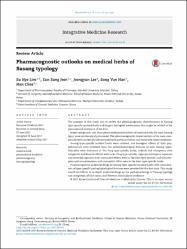| dc.contributor.author | Lim, Su Hye | |
| dc.contributor.author | Sang Jeon, Eun | |
| dc.contributor.author | Lee, Jeongyun | |
| dc.contributor.author | Han, Sang Yun | |
| dc.contributor.author | Chae, Han | |
| dc.date.accessioned | 10.07.201910:49:13 | |
| dc.date.accessioned | 2019-07-10T19:56:27Z | |
| dc.date.available | 10.07.201910:49:13 | |
| dc.date.available | 2019-07-10T19:56:27Z | |
| dc.date.issued | 2017 | en_US |
| dc.identifier.citation | Lim, S. H., Sang Jeon, E., Lee, J., Han, S. Y. ve Chae, H. (2017). Pharmacognostic outlooks on medical herbs of Sasang typology. Integrative Medicine Research, 6(3), 231-139. https://dx.doi.org/10.1016/j.imr.2017.06.005 | en_US |
| dc.identifier.issn | 2213-4220 | |
| dc.identifier.issn | 2213-4239 | |
| dc.identifier.uri | https://dx.doi.org/10.1016/j.imr.2017.06.005 | |
| dc.identifier.uri | https://hdl.handle.net/20.500.12511/2712 | |
| dc.description | WOS: 000416874500001 | en_US |
| dc.description | PubMed ID: 28951836 | en_US |
| dc.description.abstract | The purpose of this study was to review the pharmacognostic characteristics of Sasang type-specific medical herbs and suggest biological mechanisms that might be related to the personalized treatment of the East. Major compounds and their pharmacological activities of medical herbs for each Sasang types were systematically reviewed. The pharmacognostic characteristics of its main compounds were systematically analyzed with previous studies and three web-based databases. Sasang type-specific medical herbs were selected, and biological effects of their phytochemicals were reviewed from the pathophysiological features of each Sasang types. Phenolics were dominant in Tae-Yang type-specific herbs, iridoids and triterpenes with antipyretic and diuretic effects were in So-Yang type-specific, saponins (triterpene saponins and steroidal saponins) with antitussive effects were in Tae-Eum type-specific, and monoterpene and sesquiterpenes with stomachic effect were in So-Eum type-specific herbs. Pharmacognostic understandings on Sasang type-specific medical herbs with consideration of type-specific pathophysiological features were provided for the first time. This study would contribute to in-depth understandings on the pathophysiology of Sasang typology and integration of East-Asian and Western personalized medicine. | en_US |
| dc.description.sponsorship | 2-year Research Grant of Pusan National University | en_US |
| dc.description.sponsorship | This work was supported by a 2-year Research Grant of Pusan National University. | en_US |
| dc.language.iso | eng | en_US |
| dc.publisher | Elsevier Science Bv | en_US |
| dc.rights | info:eu-repo/semantics/openAccess | en_US |
| dc.rights | Attribution-NonCommercial-NoDerivatives 4.0 International | * |
| dc.rights.uri | https://creativecommons.org/licenses/by-nc-nd/4.0/ | * |
| dc.subject | Medical Herb | en_US |
| dc.subject | Personalized Medicine | en_US |
| dc.subject | Pharmacognosy | en_US |
| dc.subject | Sasang Typology | en_US |
| dc.title | Pharmacognostic outlooks on medical herbs of Sasang typology | en_US |
| dc.type | review | en_US |
| dc.relation.ispartof | Integrative Medicine Research | en_US |
| dc.department | İstanbul Medipol Üniversitesi, Tıp Fakültesi, Dahili Tıp Bilimleri Bölümü, Geleneksel ve Tamamlayıcı Tıp (İntegratif Tıp) Ana Bilim Dalı | en_US |
| dc.identifier.volume | 6 | en_US |
| dc.identifier.issue | 3 | en_US |
| dc.identifier.startpage | 231 | en_US |
| dc.identifier.endpage | 239 | en_US |
| dc.relation.publicationcategory | Diğer | en_US |
| dc.identifier.doi | 10.1016/j.imr.2017.06.005 | en_US |
| dc.identifier.wosquality | Q3 | en_US |



















